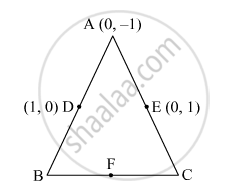Advertisements
Advertisements
Question
In \[∆\] ABC , the coordinates of vertex A are (0, - 1) and D (1,0) and E(0,10) respectively the mid-points of the sides AB and AC . If F is the mid-points of the side BC , find the area of \[∆\] DEF.
Solution

Let the coordinates of B and C be \[\left( x_2 , y_2 \right)\] and \[\left( x_3 , y_3 \right)\] , respectively.
D is the midpoint of AB.
So,
\[\left( 1, 0 \right) = \left( \frac{x_2 + 0}{2}, \frac{y_2 - 1}{2} \right)\]
\[ \Rightarrow 1 = \frac{x_2}{2} \text { and } 0 = \frac{y_2 - 1}{2}\]
\[ \Rightarrow x_2 = 2 \text{ and } y_2 = 1\]
Thus, the coordinates of B are (2, 1).
Similarly, E is the midpoint of AC.
So,
\[\left( 0, 1 \right) = \left( \frac{x_3 + 0}{2}, \frac{y_3 - 1}{2} \right)\]
\[ \Rightarrow 0 = \frac{x_3}{2} \text{ and } 1 = \frac{y_3 - 1}{2}\]
\[ \Rightarrow x_3 = 0 \text{ and } y_3 = 3\]
Thus, the coordinates of C are (0, 3).
Also, F is the midpoint of BC. So, its coordinates are \[\left( \frac{2 + 0}{2}, \frac{1 + 3}{2} \right) = \left( 1, 2 \right)\]
\[\frac{1}{2}\left[ 0\left( 1 - 3 \right) + 2\left( 3 + 1 \right) + 0\left( - 1 - 1 \right) \right]\]
\[ = \frac{1}{2} \times 8\]
\[ = 4 \text{ square units } \]
And the area of \[∆\] DEF is
\[\frac{1}{2}\left[ 1\left( 1 - 2 \right) + 0\left( 2 - 0 \right) + 1\left( 0 - 1 \right) \right]\]
\[ = \frac{1}{2} \times \left( - 2 \right)\]
\[ = 1 \text{ square unit } \left( \text{ Taking the numerical value, as the area cannot be negative } \right)\]
APPEARS IN
RELATED QUESTIONS
Show that the points (−3, 2), (−5,−5), (2, −3) and (4, 4) are the vertices of a rhombus. Find the area of this rhombus.
If (−2, 3), (4, −3) and (4, 5) are the mid-points of the sides of a triangle, find the coordinates of its centroid.
Prove that the points (0, 0), (5, 5) and (-5, 5) are the vertices of a right isosceles triangle.
If p(x , y) is point equidistant from the points A(6, -1) and B(2,3) A , show that x – y = 3
`"Find the ratio in which the poin "p (3/4 , 5/12) " divides the line segment joining the points "A (1/2,3/2) and B (2,-5).`
In what ratio does the line x - y - 2 = 0 divide the line segment joining the points A (3, 1) and B (8, 9)?
If the points P (a,-11) , Q (5,b) ,R (2,15) and S (1,1). are the vertices of a parallelogram PQRS, find the values of a and b.
Find the area of quadrilateral ABCD whose vertices are A(-3, -1), B(-2,-4) C(4,-1) and D(3,4)
If the point A(0,2) is equidistant from the points B(3,p) and C(p, 5), find p.
In what ratio does the point C (4,5) divides the join of A (2,3) and B (7,8) ?
Find the coordinates of the circumcentre of a triangle whose vertices are (–3, 1), (0, –2) and (1, 3).
Points (−4, 0) and (7, 0) lie
If A(−3, 5), B(−2, −7), C(1, −8) and D(6, 3) are the vertices of a quadrilateral ABCD, find its area.
Find the value of k, if the points A(7, −2), B (5, 1) and C (3, 2k) are collinear.
what is the value of \[\frac{a^2}{bc} + \frac{b^2}{ca} + \frac{c^2}{ab}\] .
Write the formula for the area of the triangle having its vertices at (x1, y1), (x2, y2) and (x3, y3).
If A (1, 2) B (4, 3) and C (6, 6) are the three vertices of a parallelogram ABCD, find the coordinates of fourth vertex D.
If A (5, 3), B (11, −5) and P (12, y) are the vertices of a right triangle right angled at P, then y=
The points whose abscissa and ordinate have different signs will lie in ______.
The coordinates of a point whose ordinate is `-1/2` and abscissa is 1 are `-1/2, 1`.
